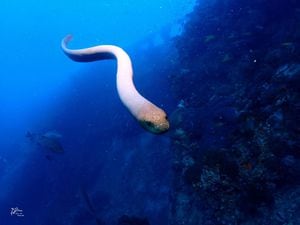Sea snake attack on divers may be ‘misdirected courtship behaviours’
Male olive sea snakes are more likely to attack humans during mating season, researchers have found.

Misdirected courtship behaviour could be a reason why scuba divers are subject to unprovoked attacks by sea snakes, according to scientists.
New research, published in the journal Scientific Reports, suggests male olive sea snakes are more likely to attack humans during mating season.
During attacks, the snakes flick their tongues and coil themselves around a limb – which are behaviours also associated with courtship.
The scientists said that fleeing from these snakes “may inadvertently mimic the responses of female snakes to courtship, encouraging males to give chase”.
They added: “To prevent escalation of encounters, divers should keep still and avoid retaliation.”

Olive sea snakes are highly poisonous creatures and are among the the largest marine snake species that mainly inhabit coral reefs, with adults potentially measuring more than six feet (1.8m) in length.
They can be found in coastal waters off the northern half of Australia and southern New Guinea and in the Coral Sea.
A team of experts led by Richard Shine, a professor in the department of biological sciences at Macquarie University in Australia, analysed data collected between 1994 and 1995 describing olive sea snake behaviour recorded by study co-author Tim Lynch, when he repeatedly encountered the creatures while diving in the Great Barrier Reef.
The researchers found that sea snakes approached the diver during 74 out of 158 encounters and this was more frequent between May and August – coinciding with the mating season.
About 13 encounters involved sea snakes rapidly swimming towards the diver, the researchers said.

And the encounters involving males took place immediately after an unsuccessful chase of a female, or an interaction with a male rival, the team added.
Meanwhile, rapid approaches by females took place mostly when they were being chased by males.
It is thought that sea snakes are unable to identify shapes in water, so attacks by male sea snakes may be due to mistaking a diver for a rival snake or potential mate.
For female sea snakes, the researchers believe a diver may be perceived as potential hiding place.
The experts said: “These patterns suggest that attacks by sea snakes on humans result from mistaken identity during sexual interactions.”





